Hydro-Climatic and Multi-Temporal Remote Analysis of Glacier and Moraine Lake Changes in the Ile-Alatau Mountains (1955–2024), Northern Tien Shan
Abstract
1. Introduction
2. Study Area
3. Materials and Methods
3.1. Data Acquisition
3.1.1. Hydro-Climatic Data
3.1.2. Glacier Outlines and Lake Delineation
3.2. Data Processing and Analysis
3.2.1. Hydro-Climatic Data Analysis
3.2.2. Glacier Delineation and Area Change Analysis
3.2.3. Glacial Lake Mapping and Change Analysis
3.2.4. Assessment of the Accuracy of Determining the Boundaries of Glaciers and Moraine Lakes
4. Results
4.1. Temporal Dynamics of Hydro-Climatic Variables
4.2. Glacier Area Change
4.3. Evolution of Glacial Lakes
4.4. Linkages Between Hydro-Climatic Trends and Glacier–Lake Response
5. Discussion
6. Limitations and Future Research
7. Conclusions
Author Contributions
Funding
Data Availability Statement
Acknowledgments
Conflicts of Interest
References
- Borodavko, P.S.; Volkova, E.S.; Mel`nik, M.A.; Litvinov, A.S.; Demberel, O. Climate Change Impact on High-Altitude Geomorphological Systems. IOP Conf. Ser. Earth Environ. Sci. 2018, 211, 012004. [Google Scholar] [CrossRef]
- Munroe, J.S.; Handwerger, A.L. Contribution of Rock Glacier Discharge to Late Summer and Fall Streamflow in the Uinta Mountains, Utah, USA. Hydrol. Earth Syst. Sci. 2023, 27, 543–557. [Google Scholar] [CrossRef]
- Pepin, N.C.; Arnone, E.; Gobiet, A.; Haslinger, K.; Kotlarski, S.; Notarnicola, C.; Palazzi, E.; Seibert, P.; Serafin, S.; Schöner, W.; et al. Climate Changes and Their Elevational Patterns in the Mountains of the World. Rev. Geophys. 2022, 60, e2020RG000730. [Google Scholar] [CrossRef]
- Qureshi, M.A.; Yi, C.; Xu, X.; Li, Y. Glacier Status during the Period 1973–2014 in the Hunza Basin, Western Karakoram. Quat. Int. 2017, 444, 125–136. [Google Scholar] [CrossRef]
- Kraaijenbrink, P.D.A.; Stigter, E.E.; Yao, T.; Immerzeel, W.W. Climate Change Decisive for Asia’s Snow Meltwater Supply. Nat. Clim. Change 2021, 11, 591–597. [Google Scholar] [CrossRef]
- Romshoo, S.A.; Abdullah, T.; Rashid, I.; Bahuguna, I.M. Explaining the Differential Response of Glaciers across Different Mountain Ranges in the North-Western Himalaya, India. Cold Reg. Sci. Technol. 2022, 196, 103515. [Google Scholar] [CrossRef]
- Mukhtar, K. The Impact of Climate Change on the Seismic Vulnerability of the Megalopolis of Almaty. Int. J. Hydrol. 2019, 3, 52–56. [Google Scholar] [CrossRef]
- Zhang, Q.; Shen, Z.; Pokhrel, Y.; Farinotti, D.; Singh, V.P.; Xu, C.Y.; Wu, W.; Wang, G. Oceanic Climate Changes Threaten the Sustainability of Asia’s Water Tower. Nature 2023, 615, 87–93. [Google Scholar] [CrossRef]
- Palomo, I. Climate Change Impacts on Ecosystem Services in High Mountain Areas: A Literature Review. Mt. Res. Dev. 2017, 37, 179–187. [Google Scholar] [CrossRef]
- Li, J.; Sun, M.; Yao, X.; Duan, H.; Zhang, C.; Wang, S.; Niu, S.; Yan, X. A Review of Karakoram Glacier Anomalies in High Mountains Asia. Water 2023, 15, 3215. [Google Scholar] [CrossRef]
- Wu, F.; Zhan, J.; Wang, Z.; Zhang, Q. Streamflow Variation Due to Glacier Melting and Climate Change in Upstream Heihe River Basin, Northwest China. Phys. Chem. Earth Parts A/B/C 2015, 79–82, 11–19. [Google Scholar] [CrossRef]
- Huss, M.; Hock, R. Global-Scale Hydrological Response to Future Glacier Mass Loss. Nat. Clim. Change 2018, 8, 135–140. [Google Scholar] [CrossRef]
- Azam, M.F.; Wagnon, P.; Vincent, C.; Ramanathan, A.L.; Kumar, N.; Srivastava, S.; Pottakkal, J.G.; Chevallier, P. Snow and Ice Melt Contributions in a Highly Glacierized Catchment of Chhota Shigri Glacier (India) over the Last Five Decades. J. Hydrol. 2019, 574, 760–773. [Google Scholar] [CrossRef]
- You, Q.-L.; Ren, G.-Y.; Zhang, Y.-Q.; Ren, Y.-Y.; Sun, X.-B.; Zhan, Y.-J.; Shrestha, A.B.; Krishnan, R. An Overview of Studies of Observed Climate Change in the Hindu Kush Himalayan (HKH) Region. Adv. Clim. Change Res. 2017, 8, 141–147. [Google Scholar] [CrossRef]
- He, Y.; Yang, T.; Ji, Q.; Chen, J.; Zhao, G.; Shao, W. Glacier Variation in Response to Climate Change in Chinese Tianshan Mountains from 1989 to 2012. J. Mt. Sci. 2015, 12, 1189–1202. [Google Scholar] [CrossRef]
- Zhang, Q.; Chen, Y.; Li, Z.; Xiang, Y.; Li, Y.; Sun, C. Recent Changes in Glaciers in the Northern Tien Shan, Central Asia. Remote Sens. 2022, 14, 2878. [Google Scholar] [CrossRef]
- Aizen, V.B.; Kuzmichenok, V.A.; Surazakov, A.B.; Aizen, E.M. Glacier Changes in the Central and Northern Tien Shan during the Last 140 Years Based on Surface and Remote-Sensing Data. Ann. Glaciol. 2006, 43, 202–213. [Google Scholar] [CrossRef]
- Che, Y.; Zhang, M.; Li, Z.; Wang, S.; Du, M.; Wang, P.; Wang, J.; Zhou, P. Quantitative Evaluation of Glacier Change and Its Response to Climate Change in the Chinese Tien Shan. Cold Reg. Sci. Technol. 2018, 153, 144–155. [Google Scholar] [CrossRef]
- Ahmad, Z.; Altaf, F.; Kamp, U.; Rahman, F.; Malik, S.M. Glacier Recession and Climate Change in Chitral, Eastern Hindu Kush Mountains of Pakistan, Between 1992 and 2022. Geosciences 2025, 15, 167. [Google Scholar] [CrossRef]
- Bhattacharya, A.; Bolch, T.; Mukherjee, K.; King, O.; Menounos, B.; Kapitsa, V.; Neckel, N.; Yang, W.; Yao, T. High Mountain Asian Glacier Response to Climate Revealed by Multi-Temporal Satellite Observations since the 1960s. Nat. Commun. 2021, 12, 4133. [Google Scholar] [CrossRef] [PubMed]
- Du, W.; Li, J.; Bao, A.; Wang, B. Mapping Changes in the Glaciers of the Eastern Tienshan Mountains during 1977–2013 Using Multitemporal Remote Sensing. J. Appl. Remote Sens. 2014, 8, 084683. [Google Scholar] [CrossRef]
- Baig, S.U.; Khan, H.; Muneeb, F.; Dad, K. Formation of a Hazardous Ice-Dammed Glacier Lake: A Case Study of Anomalous Behavior of Hassanabad Glacier System in the Karakoram. SN Appl. Sci. 2020, 2, 1285. [Google Scholar] [CrossRef]
- Zhang, Z.; Zhao, J.; Liu, S.; Zhang, Q.; Jiang, Z.; Xu, Y.; Su, H. Characterization of Three Surges of the Kyagar Glacier, Karakoram. Remote Sens. 2023, 15, 2113. [Google Scholar] [CrossRef]
- Daiyrov, M.; Narama, C.; Kääb, A.; Tadono, T. Formation and Outburst of the Toguz-Bulak Glacial Lake in the Northern Teskey Range, Tien Shan, Kyrgyzstan. Geosciences 2020, 10, 468. [Google Scholar] [CrossRef]
- Zhou, P.; Zhang, H.; Li, Z. Impact of Climate Change on the Glacier and Runoff of a Glacierized Basin in Harlik Mountain, Eastern Tianshan Mountains. Remote Sens. 2022, 14, 3497. [Google Scholar] [CrossRef]
- Petrakov, D.; Shpuntova, A.; Aleinikov, A.; Kääb, A.; Kutuzov, S.; Lavrentiev, I.; Stoffel, M.; Tutubalina, O.; Usubaliev, R. Accelerated Glacier Shrinkage in the Ak-Shyirak Massif, Inner Tien Shan, during 2003–2013. Sci. Total Environ. 2016, 562, 364–378. [Google Scholar] [CrossRef]
- Bolch, T. Climate Change and Glacier Retreat in Northern Tien Shan (Kazakhstan/Kyrgyzstan) Using Remote Sensing Data. Glob. Planet. Change 2007, 56, 1–12. [Google Scholar] [CrossRef]
- Severskiy, I.; Vilesov, E.; Armstrong, R.; Kokarev, A.; Kogutenko, L.; Usmanova, Z.; Morozova, V.; Raup, B. Changes in Glaciation of the Balkhash–Alakol Basin, Central Asia, over Recent Decades. Ann. Glaciol. 2016, 57, 382–394. [Google Scholar] [CrossRef]
- Blagovechshenskiy, V.; Kapitsa, V.; Kasatkin, N. Danger of GLOFs in the Mountain Areas of Kazakhstan. J. Earth Sci. Eng. 2015, 5, 182–187. [Google Scholar] [CrossRef]
- Medeu, A.R.; Popov, N.V.; Blagovechshenskiy, V.P.; Askarova, M.A.; Medeu, A.A.; Ranova, S.U.; Kamalbekova, A.; Bolch, T. Moraine-Dammed Glacial Lakes and Threat of Glacial Debris Flows in South-East Kazakhstan. Earth-Sci. Rev. 2022, 229, 103999. [Google Scholar] [CrossRef]
- Mussina, A.; Abdullayeva, A.; Barandun, M.; Cicoira, A.; Tursyngali, M. Assessment of the current state and temporal changes of glacial-moraine lakes in the Central and Eastern part of the northern slope of the Ile Alatau, Kazakhstan. J. Water Land Dev. 2024, 63 (X–XII), 19–24. [Google Scholar] [CrossRef]
- Nurakynov, S.; Kaldybayev, A.; Zulpykharov, K.; Sydyk, N.; Merekeyev, A.; Chepashev, D.; Nyssanbayeva, A.; Issanova, G.; Fang, G. Accelerated Glacier Area Loss in the Zhetysu (Dzhungar) Alatau Range (Tien Shan) for the Period of 1956–2016. Remote Sens. 2023, 15, 2133. [Google Scholar] [CrossRef]
- Kapitsa, V.; Shahgedanova, M.; Machguth, H.; Severskiy, I.; Medeu, A. Assessment of Evolution and Risks of Glacier Lake Outbursts in the Djungarskiy Alatau, Central Asia, Using Landsat Imagery and Glacier Bed Topography Modelling. Nat. Hazards Earth Syst. Sci. 2017, 17, 1837–1856. [Google Scholar] [CrossRef]
- Zhao, Q.; Zhang, S.; Ding, Y.J.; Wang, J.; Han, H.; Xu, J.; Zhao, C.; Guo, W.; Shangguan, D. Modeling Hydrologic Response to Climate Change and Shrinking Glaciers in the Highly Glacierized Kunma Like River Catchment, Central Tian Shan. J. Hydrometeorol. 2015, 16, 2383–2402. [Google Scholar] [CrossRef]
- Liu, J.; Lawson, D.E.; Hawley, R.L.; Chipman, J.; Tracy, B.; Shi, X.; Chen, Y. Estimating the Longevity of Glaciers in the Xinjiang Region of the Tian Shan through Observations of Glacier Area Change since the Little Ice Age Using High-Resolution Imagery. J. Glaciol. 2020, 66, 471–484. [Google Scholar] [CrossRef]
- Sun, M.; Li, Z.; Yao, X.; Zhang, M.; Jin, S. Modeling the Hydrological Response to Climate Change in a Glacierized High Mountain Region, Northwest China. J. Glaciol. 2015, 61, 127–136. [Google Scholar] [CrossRef]
- Gao, J.; Du, J.; Bai, Y.; Chen, T.; Zhuoma, Y. The Impact of Climate Change on Glacial Lake Outburst Floods. Water 2024, 16, 1742. [Google Scholar] [CrossRef]
- Vilesov, E.N.; Khonin, R.V. Central and Southern Kazakhstan, Lake Balkhash Basin. Basins of the Left Tributaries of the Ili River from the Mouth of the Kurty River to the Mouth of the Turgen River, Part 1. In Catalogue of Glaciers of the USSR; Hydrometeoizdat: Leningrad, Russia, 1967; Volume 13, Issue 2. [Google Scholar]
- Sydyk, N.; Iskaliyeva, G.; Sagat, M.; Merekeyev, A.; Balakay, L.; Kaldybayev, A.; Baygurin, Z.; Abishev, B. The Impact of Climate Change on the State of Moraine Lakes in Northern Tian Shan: Case Study on Four Moraine Lakes. Water 2025, 17, 2533. [Google Scholar] [CrossRef]
- Chigrinets, A.G.; Duskayev, K.K.; Mazur, L.P.; Chigrinets, L.; Akhmetova, S.T.; Mussina, A.K. Evaluation and Dynamics of the Glacial Runoff of the Rivers of the Ile Alatau Northern Slope in the Context of Global Warming. Int. J. Eng. Res. Technol. 2020, 13, 419. [Google Scholar] [CrossRef]
- Gul, J.; Muhammad, S.; Liu, S.; Ullah, S.; Ahmad, S.; Hayat, H.; Tahir, A.A. Spatio-Temporal Changes in the Six Major Glaciers of the Chitral River Basin (Hindukush Region of Pakistan) between 2001 and 2018. J. Mt. Sci. 2020, 17, 572–587. [Google Scholar] [CrossRef]
- Liu, Q.; Huang, C. Spatiotemporal Change of Water Balance Components in the Inland Region of Northwest China, 1998–2017. Resour. Sci. 2020, 42, 1175–1187. [Google Scholar] [CrossRef]
- Huang, Z.; Xu, J.; Zheng, L. Long-Term Change of Lake Water Storage and Its Response to Climate Change for Typical Lakes in Arid Xinjiang, China. Water 2023, 15, 1444. [Google Scholar] [CrossRef]
- Singh, V.; Jain, S.K.; Shukla, S. Glacier Change and Glacier Runoff Variation in the Himalayan Baspa River Basin. J. Hydrol. 2021, 593, 125918. [Google Scholar] [CrossRef]
- Yue, X.; Li, Z.; Li, H.; Wang, P.; Wang, L.; Zhao, J. Changes in the End-of-Summer Snow Line Altitude of Summer-Accumulation-Type Glaciers in the Eastern Tien Shan Mountains from 1994 to 2016. Remote Sens. 2021, 13, 1080. [Google Scholar] [CrossRef]
- He, Q.; Yang, J.; Zhao, Q.; Chen, H.; Wang, Y.; Wang, H.; Wang, X. Assessment of Water Resource Sustainability and Glacier Runoff Impact on the Northern and Southern Slopes of the Tianshan Mountains. Sustainability 2025, 17, 4812. [Google Scholar] [CrossRef]
- Kaldybayev, A.; Chen, Y.; Vilesov, E. Glacier Change in the Karatal River Basin, Zhetysu (Dzhungar) Alatau, Kazakhstan. Ann. Glaciol. 2016, 57, 11–19. [Google Scholar] [CrossRef]
- Zhang, Q.; Chen, Y.; Li, Z.; Li, Y.; Xiang, Y.; Bian, W. Glacier Changes from 1975 to 2016 in the Aksu River Basin, Central Tianshan Mountains. J. Geogr. Sci. 2019, 29, 984–1000. [Google Scholar] [CrossRef]
- Central and Southern Kazakhstan. Balkhash Lake Basin, Part 2. In Hydrometeoizdat Surface Water Resources of the USSR; Hydrometeoizdat: Leningrad, Russia, 1970; Volume 13, p. 114.
- Qureshi, M.A.; Li, Y.; Yi, C.; Xu, X. Glacial Changes in the Hunza Basin, Western Karakoram, since the Little Ice Age. Palaeogeogr. Palaeoclimatol. Palaeoecol. 2021, 562, 110086. [Google Scholar] [CrossRef]
- Li, Y.; Li, Y. Topographic and Geometric Controls on Glacier Changes in the Central Tien Shan, China, since the Little Ice Age. Ann. Glaciol. 2014, 55, 177–186. [Google Scholar] [CrossRef]
- Gholami, H.; Moradi, Y.; Lotfirad, M.; Gandomi, M.A.; Bazgir, N.; Shokrian Hajibehzad, M. Detection of Abrupt Shift and Non-Parametric Analyses of Trends in Runoff Time Series in the Dez River Basin. Water Supply 2022, 22, 1216–1230. [Google Scholar] [CrossRef]
- Jawak, S.D.; Wankhede, S.F.; Luis, A.J.; Balakrishna, K. Impact of Image-Processing Routines on Mapping Glacier Surface Facies from Svalbard and the Himalayas Using Pixel-Based Methods. Remote Sens. 2022, 14, 1414. [Google Scholar] [CrossRef]
- Li, X.; Wang, L.; Hu, B.; Chen, D.; Liu, R. Contribution of Vanishing Mountain Glaciers to Global and Regional Terrestrial Water Storage Changes. Front. Earth Sci. 2023, 11, 1134910. [Google Scholar] [CrossRef]
- Guo, W.; Liu, S.; Xu, J.; Wu, L.; Shangguan, D.; Yao, X.; Wei, J.; Bao, W.; Yu, P.; Liu, Q.; et al. The Second Chinese Glacier Inventory: Data, Methods and Results. J. Glaciol. 2015, 61, 357–372. [Google Scholar] [CrossRef]
- Wang, H.; Yang, R.; Li, X.; Cao, S. Glacier Parameter Extraction Using Landsat 8 Images in the Eastern Karakorum. IOP Conf. Ser. Earth Environ. Sci. 2017, 57, 012004. [Google Scholar] [CrossRef]
- Racoviteanu, A.E.; Paul, F.; Raup, B.; Khalsa, S.J.S.; Armstrong, R. Challenges and Recommendations in Mapping of Glacier Parameters from Space: Results of the 2008 Global Land Ice Measurements from Space (GLIMS) Workshop, Boulder, Colorado, USA. Ann. Glaciol. 2009, 50, 53–69. [Google Scholar] [CrossRef]
- Paul, F.; Kääb, A. Perspectives on the Production of a Glacier Inventory from Multispectral Satellite Data in Arctic Canada: Cumberland Peninsula, Baffin Island. Ann. Glaciol. 2005, 42, 59–66. [Google Scholar] [CrossRef]
- Tak, S.; Keshari, A.K. Investigating Mass Balance of Parvati Glacier in Himalaya Using Satellite Imagery Based Model. Sci. Rep. 2020, 10, 12211. [Google Scholar] [CrossRef] [PubMed]
- Otsu, N. A Threshold Selection Method from Gray-Level Histograms. IEEE Trans. Syst. Man Cybern. 1979, 9, 62–66. [Google Scholar] [CrossRef]
- Zhou, N.; Dixon, S.; Zhu, Z.; Dong, L.; Weiner, M. Spectrotemporal Modulation Sensitivity in Cochlear-Implant and Normal-Hearing Listeners: Is the Performance Driven by Temporal or Spectral Modulation Sensitivity? Trends Hear. 2020, 24, 2331216520948385. [Google Scholar] [CrossRef]
- Hanshaw, M.N.; Bookhagen, B. Glacial Areas, Lake Areas, and Snowlines from 1975 to 2012: Status of the Cordillera Vilcanota, Including the Quelccaya Ice Cap, Northern Central Andes, Peru. Cryosphere 2013, 8, 359–376. [Google Scholar] [CrossRef]
- Ji, L.; Zhang, L.; Wylie, B. Analysis of Dynamic Thresholds for the Normalized Difference Water Index. Photogramm. Eng. Remote Sens. 2009, 75, 1307–1317. [Google Scholar] [CrossRef]
- Deng, J.; Long, Y.; Zhang, J.; Gao, H.; Liu, S. A Water Body Boundary Search Method Combining Chemotaxis Mechanism and High-Resolution Grid Based on Unmanned Surface Vehicles. J. Mar. Sci. Eng. 2025, 13, 958. [Google Scholar] [CrossRef]
- Tielidze, L.G.; Nosenko, G.A.; Khromova, T.E.; Paul, F. Strong Acceleration of Glacier Area Loss in the Greater Caucasus between 2000 and 2020. Cryosphere 2022, 16, 489–504. [Google Scholar] [CrossRef]
- Paul, F.; Bolch, T.; Briggs, K.; Kääb, A.; McMillan, M.; McNabb, R.; Nagler, T.; Nuth, C.; Rastner, P.; Strozzi, T.; et al. Error Sources and Guidelines for Quality Assessment of Glacier Area, Elevation Change, and Velocity Products Derived from Satellite Data in the Glaciers_cci Project. Remote Sens. Environ. 2017, 203, 256–275. [Google Scholar] [CrossRef]
- Bolch, T.; Yao, T.; Kang, S.; Buchroithner, M.F.; Scherer, D.; Maussion, F.; Huintjes, E.; Schneider, C. A Glacier Inventory for the Western Nyainqentanglha Range and the Nam Co Basin, Tibet, and Glacier Changes 1976–2009. Cryosphere 2010, 4, 419–433. [Google Scholar] [CrossRef]
- Paul, F.; Barrand, N.E.; Baumann, S.; Berthier, E.; Bolch, T.; Casey, K.; Frey, H.; Joshi, S.P.; Konovalov, V.; Le Bris, R.; et al. On the Accuracy of Glacier Outlines Derived from Remote-Sensing Data. Ann. Glaciol. 2013, 54, 171–182. [Google Scholar] [CrossRef]
- Singh, S.; Kumar, R.; Bhardwaj, A.; Kumar, R.; Singh, A. Changing Climate and Glacio-Hydrology: A Case Study of Shaune Garang Basin, Himachal Pradesh. Int. J. Hydrol. Sci. Technol. 2018, 8, 258–272. [Google Scholar] [CrossRef]
- Luo, J.; Ke, C.Q.; Seehaus, T. The West Kunlun Glacier Anomaly and Its Response to Climate Forcing during 2002–2020. Remote Sens. 2022, 14, 3465. [Google Scholar] [CrossRef]
- Pelto, B.M.; Browning, B.; Bird, L.; Moyer, A.N.; Moore, R.D. Lake Surface and Downstream River Temperature Response to the Retreat of a Lake-Terminating Glacier. Hydrol. Process. 2024, 38, e15150. [Google Scholar] [CrossRef]
- Romshoo, S.A.; Nabi, B.; Dar, R.A. Influence of Debris Cover on the Glacier Melting in the Himalaya. Cold Reg. Sci. Technol. 2024, 222, 104204. [Google Scholar] [CrossRef]
- Seier, G.; Abermann, J.; Wecht, M.; Neureiter, A.; Sulzer, W.; Kellerer-Pirklbauer, A. Thinning and Dynamics of the Glacier Terminus at the Pasterze Glacier (Austria), 2016–2021. Cold Reg. Sci. Technol. 2024, 222, 104198. [Google Scholar] [CrossRef]
- Rai, S.; Altman, J.; Kopecký, M.; Pejcha, V.; Svoboda, M.; Doležal, J. Global Warming Alters Himalayan Hemlock’s Climate Sensitivity and Growth Dynamics. Clim. Dyn. 2024, 62, 2333–2347. [Google Scholar] [CrossRef]
- Dixit, A.; Goswami, A.; Jain, S.K.; Das, P. Remote Sensing of Snow Cover Dynamics and Climate Implications in the Indus, Ganga, and Brahmaputra River Basins. Clim. Dyn. 2024, 62, 7309–7327. [Google Scholar] [CrossRef]

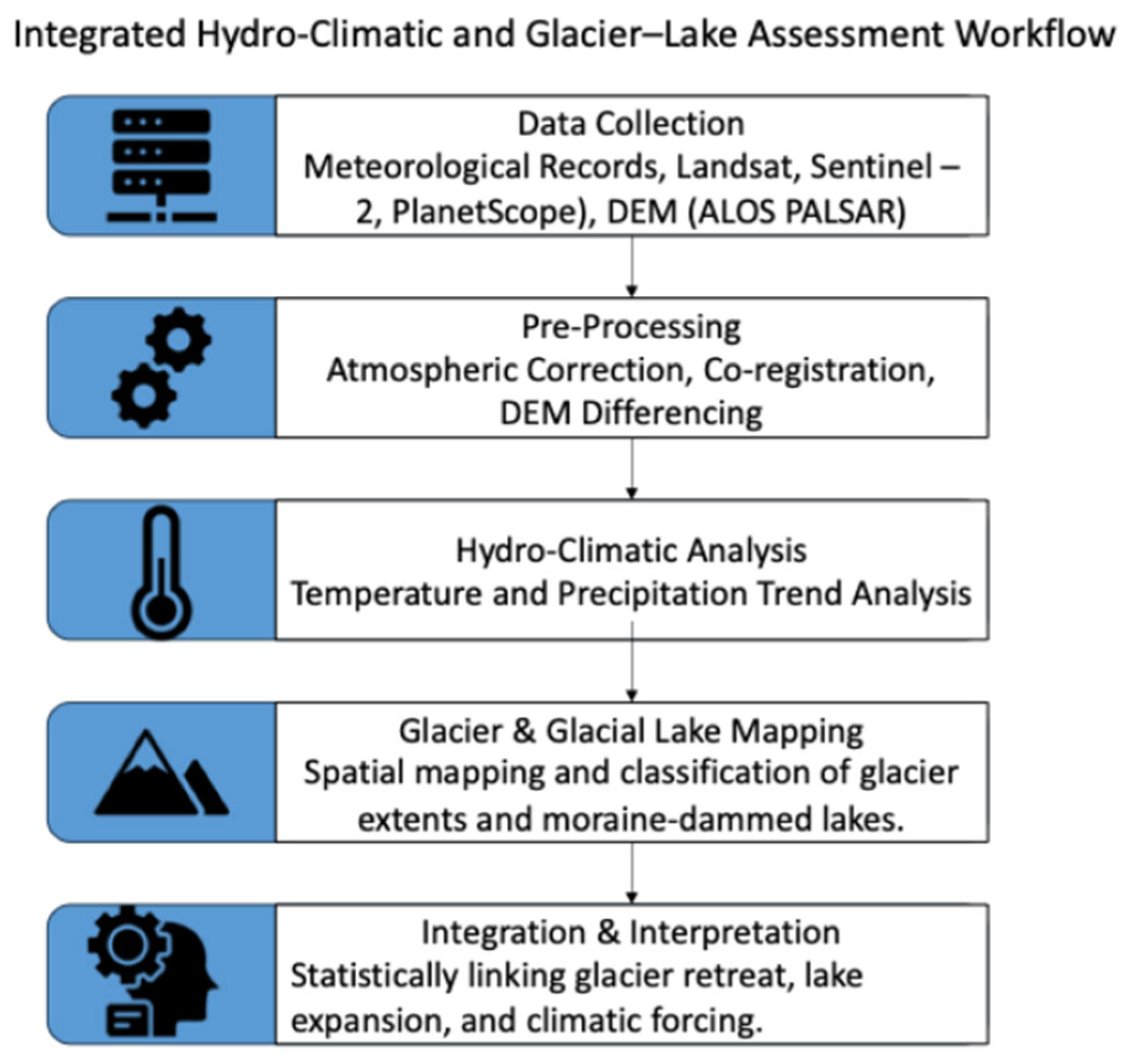


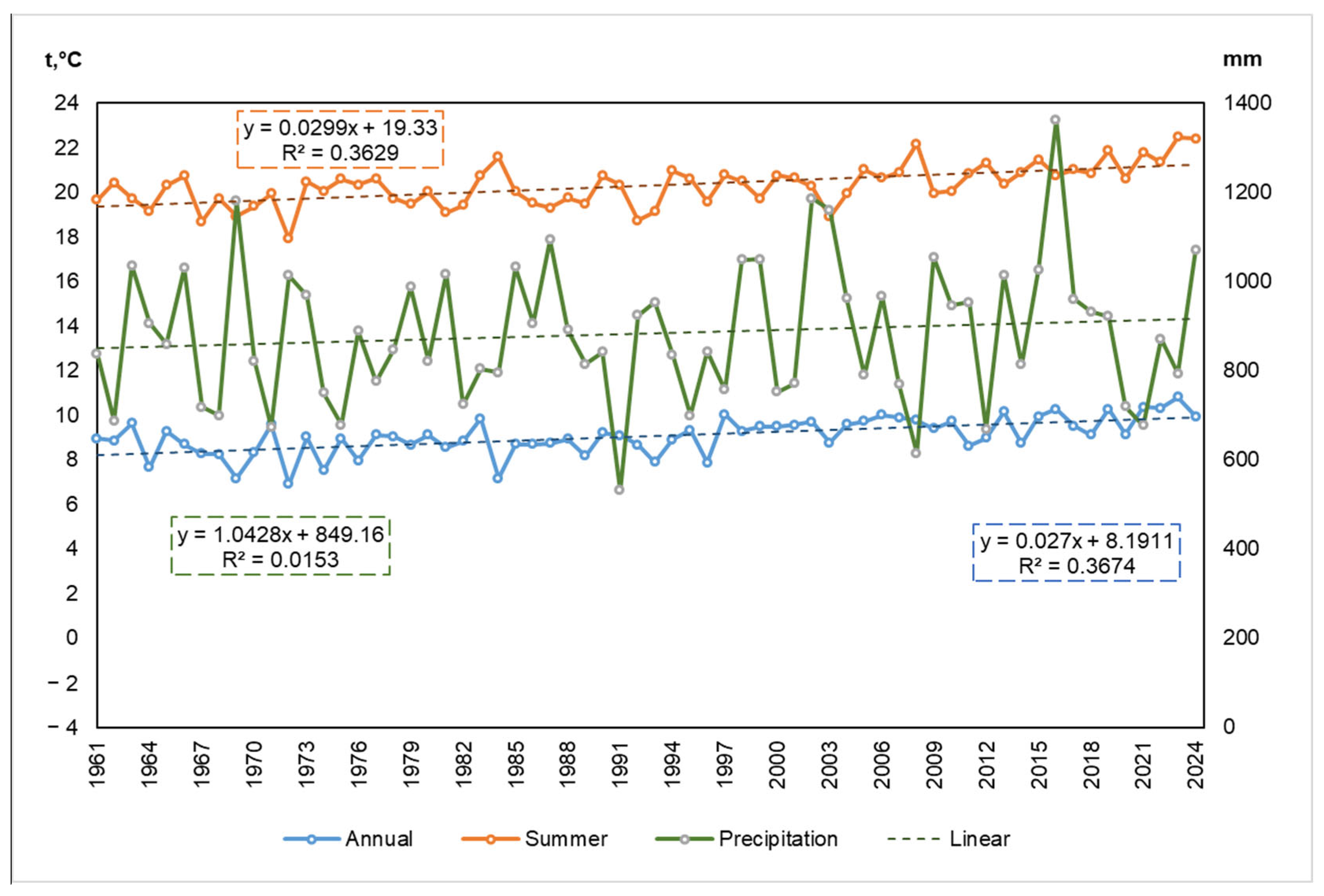
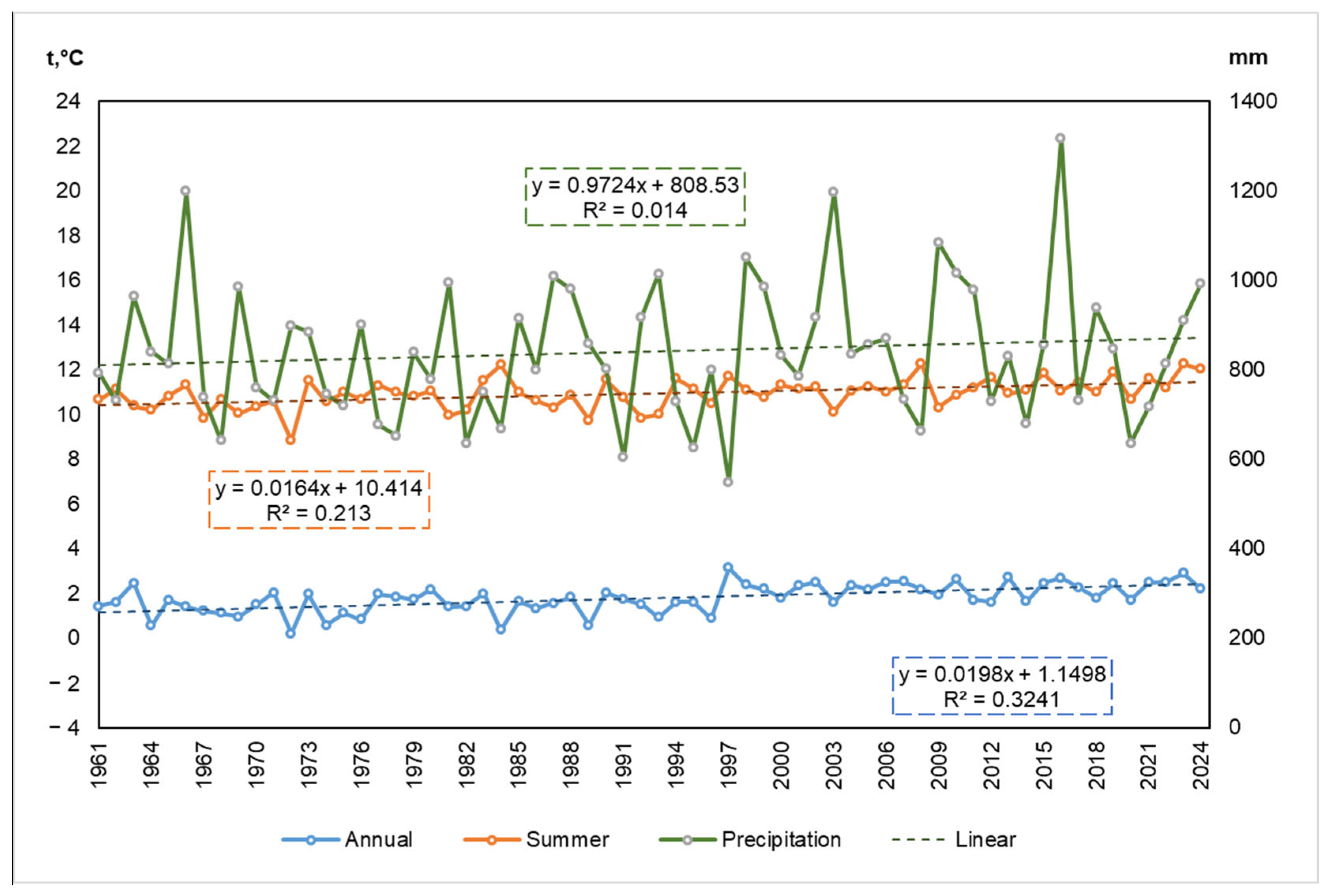


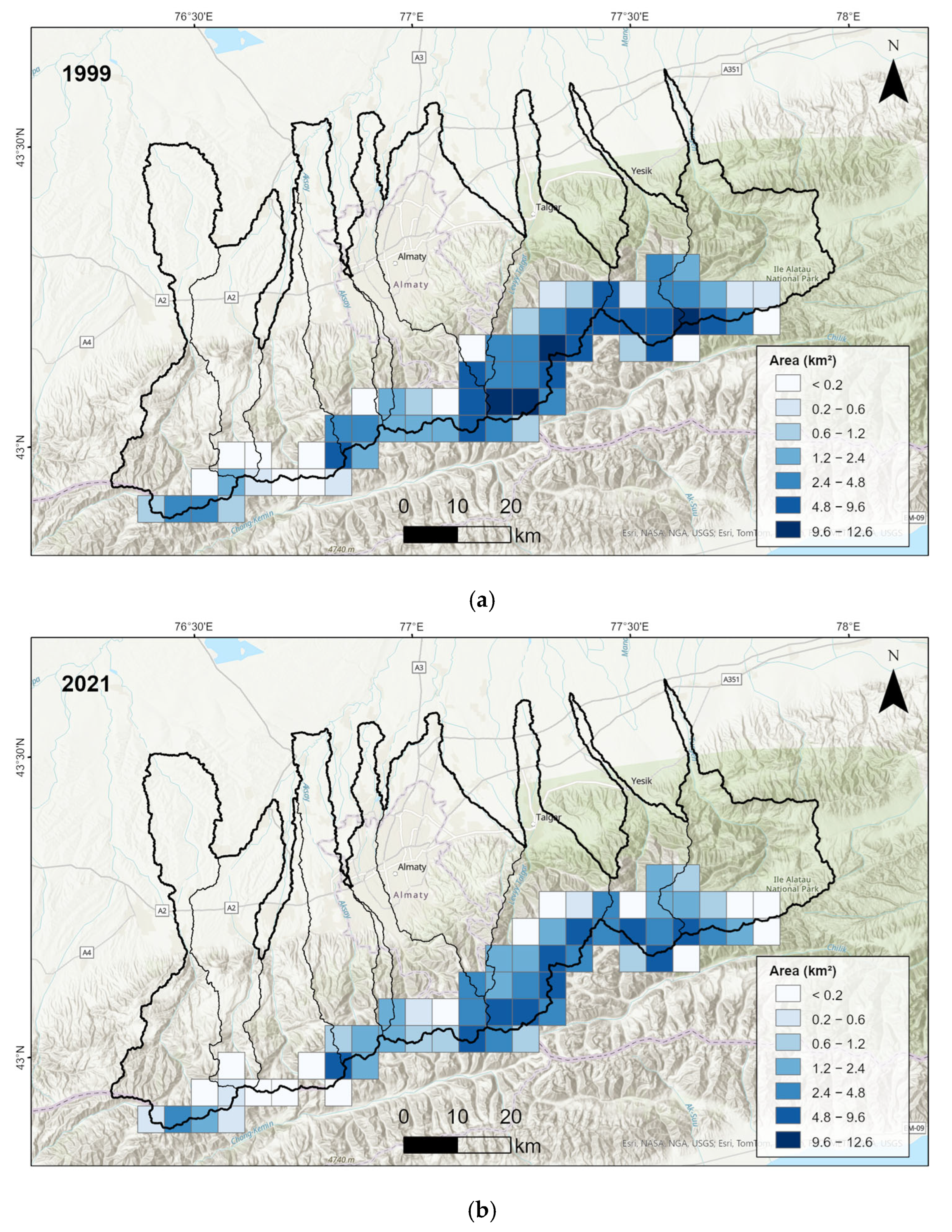

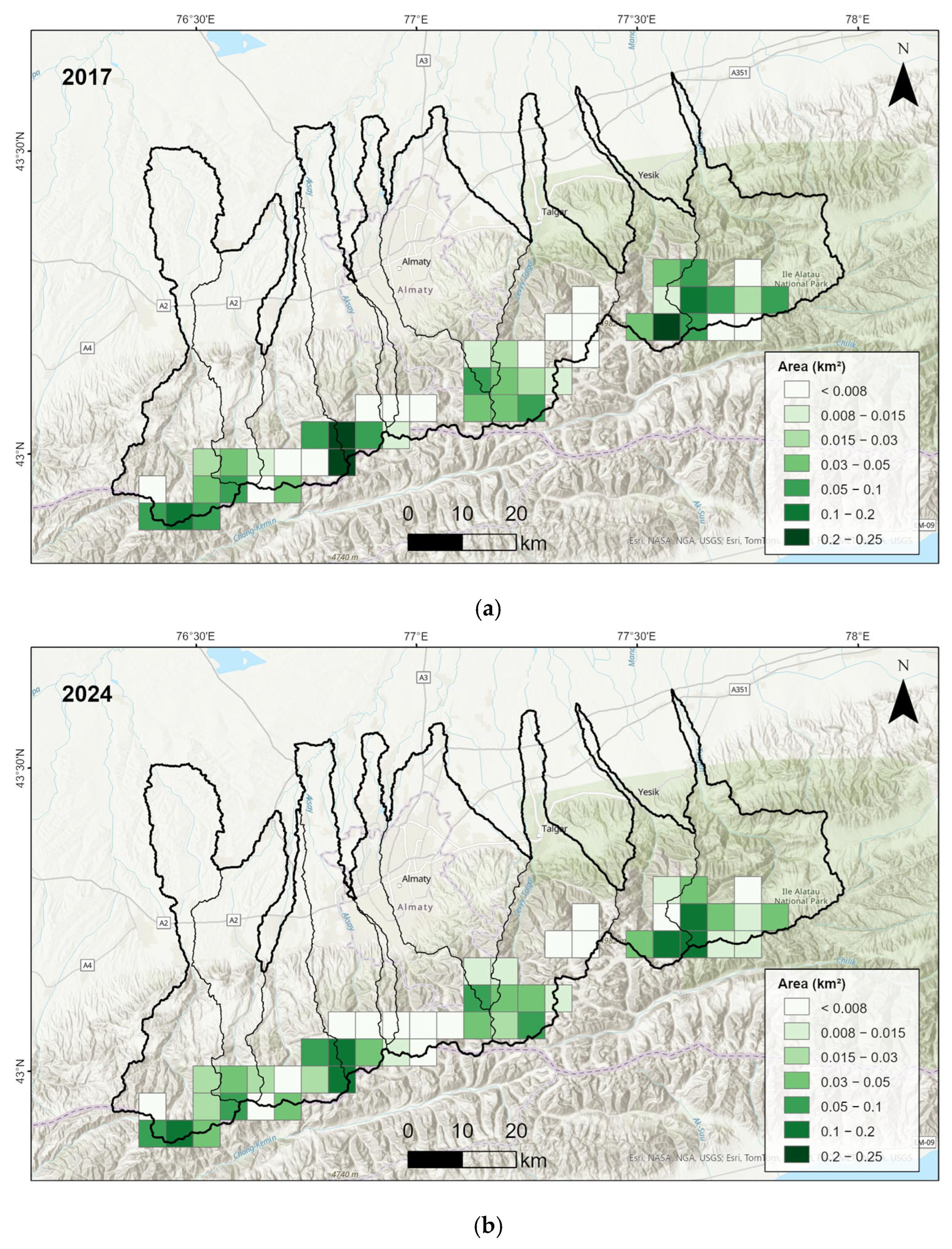
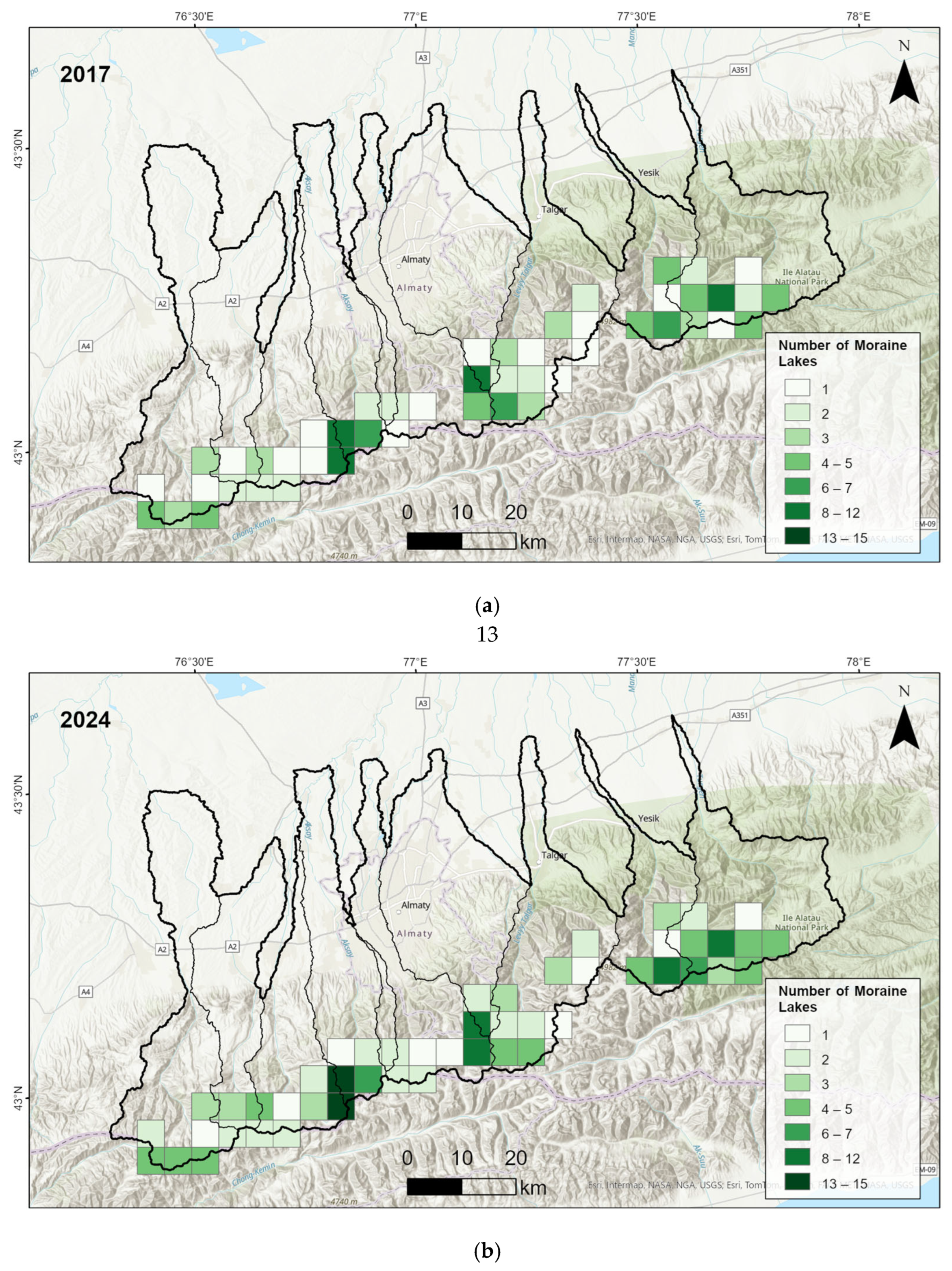

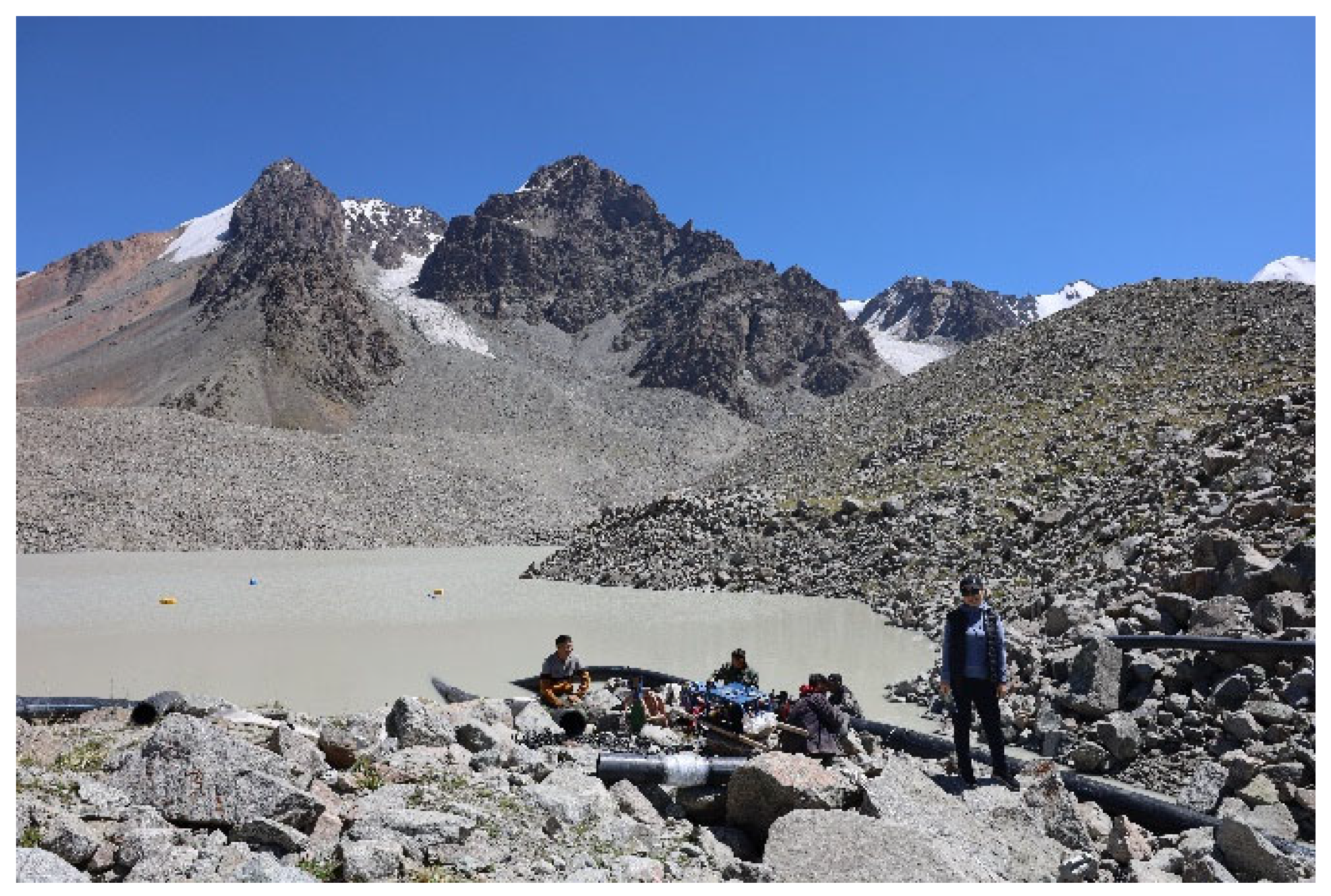
| Meteorological Station (MS) | Altitude | Coordinates | Description |
|---|---|---|---|
| Kamenskoe plateau | 1317 | 43°10.896′ N, 76°57.942′ E | Situated in the mountainous region of Zailiysky Alatau, closer to the city |
| Ulken Almaty Lake | 2517 | 43°03′ N, 76°59′ E | Situated in a mountainous region in the south-eastern part of Kazakhstan, near the city of Almaty. |
| Mynzhylky | 3017 | 43°5.1′ N, 77°4.65’ E | Situated along the northern slopes of the Zailiyskiy Alatau mountain range, in particular at the source of the Kishi Almaty River |
| Aces | 2216 | 42°15′ N, 70°08′ E | The station is located on the high-mountain plateau Assy-Turgen |
| Scene Suitability | Main | Additional Information | Main | Main | Main |
|---|---|---|---|---|---|
| WRS2 path-row | 149–030 | 150–030 | 149–030 | ||
| Date | 8 August 1999 | 16 September 1999 | 9 August 2014 | 27 September 2021 | 7 September 2021 |
| Satellite/sensor | Landsat ETM+ | Landsat ETM+ | Landsat OLI | Sentinel-2 | Sentinel-2 |
| Resolution (m) | 15/30/60 | 15/30/60 | 15/30/60 | 10/20/60 | 10/20/60 |
| Scene suitability | Main | Additional information | Main | Main | Main |
| No. | PlanetScope Acquisition Date | Sentinel-2 Acquisition Date | |
|---|---|---|---|
| 1 | 8 August 2024 | 9 August 2024 | 9 August 2017 |
| 2 | 9 August 2024 | 27 August 2024 | 31 August 2017 |
| 3 | 27 August 2024 | 28 August 2024 | 3 September 2017 |
| 4 | 31 August 2024 | 3 September 2024 | 18 September 2017 |
| Glaciers | 1 Day | 2 Day | 3 Day | 4 Day | 5 Day | Mean. km2 | Mean-Koef., km2 | Automated with 2021 TM, km2 | STD, % |
|---|---|---|---|---|---|---|---|---|---|
| No. 46 | 0.42 | 0.43 | 0.44 | 0.43 | 0.43 | 0.43 | 0.42 | 0.41 | 3.3 |
| No. 86 | 0.91 | 0.91 | 0.95 | 0.91 | 0.91 | 0.92 | 0.90 | 0.89 | 3.5 |
| No. 165 | 1.30 | 1.60 | 1.31 | 1.38 | 1.38 | 1.40 | 1.36 | 1.31 | 6.0 |
| No. 239 | 1.00 | 0.93 | 0.94 | 0.96 | 0.96 | 0.96 | 0.93 | 0.92 | 3.9 |
| Average Standard Deviation | 4.2 | ||||||||
| Basin | Name | PlanetScope | Sentinel-2 | ||||
|---|---|---|---|---|---|---|---|
| Area (m2) | Perimeter (m) | Uncertainty (%) | Area (m2) | Perimeter (m) | Uncertainty (%) | ||
| Ulken Almaty | 5 | 50,300 | 1280 | 8.7 | 50,452.3 | 1080 | 2.2 |
| Aksai | 14 | 56,300 | 1560 | 9.5 | 44,928.9 | 1285 | 2.9 |
| 15 | 49,500 | 1140 | 7.9 | 40,411.9 | 918 | 2.3 | |
| Issyk | 6 (Akkol) | 184,500 | 2220 | 4.1 | 185,415.0 | 2077 | 1.2 |
| Kaskelen | 1 | 84,600 | 1480 | 6.0 | 75,789.9 | 1302 | 1.8 |
| 2 | 85,400 | 2000 | 8.0 | 73,026.5 | 1690 | 2.4 | |
| 8 | 165,362 | 3405 | 7.1 | 138,381.0 | 2423 | 1.8 | |
| Talgar | 13 | 62,196 | 1328 | 7.3 | 63,420.2 | 1346 | 2.2 |
| Turgen | 1 | 28,200 | 800 | 9.7 | 24,837.6 | 633 | 2.6 |
| 13 | 96,034 | 1920 | 6.9 | 97,399.7 | 1755 | 1.9 | |
| 15 | 77,000 | 1800 | 8.0 | 68,771.3 | 1574 | 2.4 | |
| 16 | 70,077 | 1190 | 5.8 | 67,138.0 | 1042 | 1.6 | |
| Uzunkargaly | 7 | 99,800 | 2200 | 7.6 | 87,842.8 | 1843 | 2.2 |
| 14 | 53,500 | 1220 | 7.8 | 49,818.3 | 932 | 1.9 | |
| Chamalgan | 7 | 56,000 | 1280 | 7.9 | 54,150.3 | 991 | 1.9 |
| Mean | 2.1 | 7.5 | |||||
| Station | Mann–Kendall Stats | June | July | August | September | Mean Summer Period | Annual Mean |
|---|---|---|---|---|---|---|---|
| Kamenskoye Plateau | Z-statistic | 3.9108 | 3.0706 | 3.5399 | 3.1806 | 5.1852 | 5.2316 |
| p-value | 0.000091 | 0.00213 | 0.00040 | 0.0014 | 0.00000021 | 0.000000168 | |
| Significance | *** | ** | *** | ** | *** | *** | |
| Ulken Almaty Lake | Z-statistic | 2.8910 | 2.0683 | 1.7497 | 2.3348 | 3.7600 | 4.8029 |
| p-value | 0.0038 | 0.0386 | 0.0801 | 0.0195 | 0.000169 | 0.0000015 | |
| Significance | ** | * | * | * | *** | *** | |
| Mynzhylky | Z-statistic | 4.3452 | 3.8527 | 3.3487 | 3.4472 | 5.590 | 5.9848 |
| p-value | 0.0000139 | 0.00011679 | 0.0008117 | 0.000566 | 0.00000002259 | 0.000000002166 | |
| Significance | *** | *** | *** | *** | *** | *** | |
| Assy | Z-statistic | 2.0227 | 1.0204 | 1.9862 | 3.4622 | 1.8829 | 2.7211 |
| p-value | 0.0431 | 0.3075 | 0.047004 | 0.0005357 | 0.0597 | 0.006504 | |
| Significance | * | (N.S.) | * | *** | * | ** |
| Station | Mann–Kendall Stats | June | July | August | September | Mean Summer Period | Annual Mean |
|---|---|---|---|---|---|---|---|
| Kamenskoye Plateau | Z-statistic | −0.5098 | 0.8458 | −0.4519 | −0.2954 | −0.1564 | 0.7821 |
| p-value | 0.6101 | 0.3976 | 0.6513 | 0.7676 | 0.8756 | 0.4341 | |
| Significance | (N.S.) | (N.S.) | (N.S.) | (N.S.) | (N.S.) | (N.S.) | |
| Ulken Almaty Lake | Z-statistic | −0.4576 | 0.3070 | 0.0347 | 0.57937 | −0.0289 | 0.7937 |
| p-value | 0.6471 | 0.7587 | 0.9722 | 0.5623 | 0.9768 | 0.4273 | |
| Significance | (N.S.) | (N.S.) | (N.S.) | (N.S.) | (N.S.) | (N.S.) | |
| Mynzhylky | Z-statistic | −0.3070 | −0.8053 | 0.0869 | 0.4924 | −0.3592 | 0.3534 |
| p-value | 0.7587 | 0.4206 | 0.9307 | 0.6223 | 0.7194 | 0.7237 | |
| Significance | (N.S.) | (N.S.) | (N.S.) | (N.S.) | (N.S.) | (N.S.) | |
| Assy | Z-statistic | −2.836 | −2.7576 | −1.5854 | −2.3446 | −3.3893 | −3.9724 |
| p-value | 0.0045 | 0.0058 | 0.11287 | 0.01904 | 0.0007 | 0.000071 | |
| Significance | ** | ** | (N.S.) | * | ** | *** |
| Basins of the Ile Alatau | 1955 | 1999 | 2014 | 2021 | 1955–1999 | 1955–2021 | 1999–2014 | 1999–2021 | 2014–2021 |
|---|---|---|---|---|---|---|---|---|---|
| Area km2 | Area Decrease % (yr−1%) | ||||||||
| Uzunkargaly | 10.6 | 9.5 ± 0.4 | 6.41± 0.26 | 5.38 ± 0.22 | −10.3% (−0.2) | −49.3% (−0.7) | −32.5% (−2.2) | −43.4% (−2.0) | −16.1% (−2.3) |
| Chamalgan | 1.6 | 1.2 ± 0.05 | 0.38 ± 0.02 | 0.29 ± 0.01 | −24.6% (−0.6) | −81.9% (−0.2) | −68.4% (−4.6) | −75.9% (−3.5) | −23.8% (−3.4) |
| Kaskelen | 9.6 | 8.8 ± 0.37 | 5.95 ± 0.25 | 5.02 ± 0.21 | −8.2% (−0.2) | −47.7% (−0.7) | −32.5% (−2.2) | −43.1% (−2.0) | −15.7% (−2.2) |
| Aksai | 12.7 | 10.2 ± 0.43 | 7.06 ± 0.3 | 6.39 ± 0.26 | −19.5% (−0.4) | −49.6% (−0.8) | −30.9% (−2.1) | −37.4% (−1.7) | −9.4% (−1.3) |
| Kargaly | 3.9 | 2.5 ± 0.11 | 1.57 ± 0.07 | 1.52 ± 0.06 | −35.0% (−0.8) | −61.0% (−0.9) | −38.2% (−2.5) | −40.0% (−1.8) | −3.0% (0.4) |
| Ulken Almaty | 30.9 | 21.0 ± 0.88 | 14.24 ± 0.6 | 12.48 ± 0.52 | −32.0% (−0.7) | −59.6% (−0.9) | −32.3% (−2.2) | −40.6% (−1.8) | −12.3% (−1.8) |
| Kishi Almaty | 9.1 | 6.8 ± 0.28 | 4.64 ± 0.19 | 3.78 ± 0.16 | −25.5% (−0.6) | −58.4% (−0.9) | −31.5% (−2.1) | −44.1% (−1.8) | −18.3% (−2.6) |
| Talgar | 107.9 | 82.5 ± 3.47 | 64.96 ± 2.73 | 60.41 ± 2.54 | −23.5% (−0.5) | −44.0% (−0.7) | −21.3% (−1.4) | −26.8% (−1.2) | −7.0% (−1.0) |
| Issyk | 48.5 | 35.4 ± 1.49 | 28.22 ± 1.19 | 27.48 ± 1.15 | −27.1% (−0.6) | −43.3% (−0.7) | −20.2% (−1.3) | −22.3% (−1.0) | −2.6% (−0.4) |
| Turgen | 34.8 | 24.7 ± 1.04 | 19.49 ± 0.82 | 18.9 ± 0.79 | −28.9% (−0.7) | −45.7% (−0.7) | −21.2% (−1.4) | −23.6% (−1.1) | −3.0% (−0.4) |
| Glaciers < 0.005 km2 | 2.6 (56) | 1.1 ± 0.05 (43) | 0.82 ± 0.03 (20) | 0.71 ± 0.02 (12) | −41.5% (−0.9) | −72.5% (−1.1) | −46.2% (−3.1) | −53.0% (−2.4) | −12.6% (−1.8) |
| General indicators | 269.6 (307) | 202.7 ± 8.51 (282) | 152.9 ± 6.42 (230) | 141.7 ± 5.95 (219) | −24.8% (−0.6) | −47.4% (−0.7) | −24.6% (−1.6) | −30.1% (−2.4) | −7.4% (−1.1) |
| Basins | 2017 Sentinel-2 | 2024 Sentinel-2 | 2024 PlanetScope | |||||||
|---|---|---|---|---|---|---|---|---|---|---|
| Number | Area, m2 | According to the 2017 | New in Comparison with 2017 | Area, m2 | Percentage Change in Comparison with 2017, % | According to the 2017 | New in Comparison with 2017 | Area, m2 | Percentage Change in Comparison with 2017, % | |
| Uzunkaragaly | 18 | 329,127.4 | 17 | 2 | 307,101.3 ± 23,032.6 | −6.7 | 17 | 2 | 280,194.1 | −14.9 |
| Chamalgan | 8 | 119,600.5 | 8 | 2 | 125,672.6 ± 9425.4 | +5.1 | 8 | 4 | 127,822.2 | +6.9 |
| Kaskelen | 21 | 446,008.1 | 21 | 8 | 505,943.6 ± 37,945.8 | +13.4 | 21 | 8 | 447,680.7 | +0.4 |
| Aksai | 15 | 192,781.1 | 15 | 2 | 192,147.7 ± 14,411.1 | −0.3 | 15 | 3 | 157,158.3 | −18.5 |
| Kargaly | 2 | 5973.3 | 1 | 1 | 6290.0 ± 471.8 | +5.3 | 1 | 1 | 4527.0 | −24.2 |
| Ulken Almaty | 13 | 127,800.1 | 11 | 7 | 166,040.3 ± 12,453.0 | +29.9 | 11 | 7 | 139,036.7 | +8.8 |
| Kishi Almaty | 4 | 35,878.2 | 4 | 2 | 40,844.3 ± 3063.3 | +13.8 | 4 | 2 | 32,010.7 | −10.8 |
| Talgar | 25 | 230,325.1 | 17 | 6 | 235,357.7 ± 17,651.8 | +2.2 | 17 | 6 | 186,982.0 | −18.8 |
| Issyk | 16 | 294,623.5 | 13 | 2 | 269,541.2 ± 20,215.6 | −8.5 | 13 | 3 | 262,557.1 | −10.9 |
| Turgen | 32 | 495,825.2 | 31 | 7 | 512,792.8 ± 38,459.5 | +3.4 | 31 | 8 | 458,321.3 | −7.6 |
| 138 | 40 | 138 | 44 | |||||||
| Total | 154 | 2,277,943.0 | 178 | 2,361,731.5 ± 177,129.86 | +3.7 | 182 | 2,096,289.9 | −8.0 | ||
Disclaimer/Publisher’s Note: The statements, opinions and data contained in all publications are solely those of the individual author(s) and contributor(s) and not of MDPI and/or the editor(s). MDPI and/or the editor(s) disclaim responsibility for any injury to people or property resulting from any ideas, methods, instructions or products referred to in the content. |
© 2025 by the authors. Licensee MDPI, Basel, Switzerland. This article is an open access article distributed under the terms and conditions of the Creative Commons Attribution (CC BY) license (https://creativecommons.org/licenses/by/4.0/).
Share and Cite
Iskaliyeva, G.; Merekeyev, A.; Sydyk, N.; Amangeldi, A.A.; Abishev, B.; Baygurin, Z. Hydro-Climatic and Multi-Temporal Remote Analysis of Glacier and Moraine Lake Changes in the Ile-Alatau Mountains (1955–2024), Northern Tien Shan. Atmosphere 2025, 16, 1333. https://doi.org/10.3390/atmos16121333
Iskaliyeva G, Merekeyev A, Sydyk N, Amangeldi AA, Abishev B, Baygurin Z. Hydro-Climatic and Multi-Temporal Remote Analysis of Glacier and Moraine Lake Changes in the Ile-Alatau Mountains (1955–2024), Northern Tien Shan. Atmosphere. 2025; 16(12):1333. https://doi.org/10.3390/atmos16121333
Chicago/Turabian StyleIskaliyeva, Gulnara, Aibek Merekeyev, Nurmakhambet Sydyk, Alima Azamatkyzy Amangeldi, Bauyrzhan Abishev, and Zhaksybek Baygurin. 2025. "Hydro-Climatic and Multi-Temporal Remote Analysis of Glacier and Moraine Lake Changes in the Ile-Alatau Mountains (1955–2024), Northern Tien Shan" Atmosphere 16, no. 12: 1333. https://doi.org/10.3390/atmos16121333
APA StyleIskaliyeva, G., Merekeyev, A., Sydyk, N., Amangeldi, A. A., Abishev, B., & Baygurin, Z. (2025). Hydro-Climatic and Multi-Temporal Remote Analysis of Glacier and Moraine Lake Changes in the Ile-Alatau Mountains (1955–2024), Northern Tien Shan. Atmosphere, 16(12), 1333. https://doi.org/10.3390/atmos16121333







